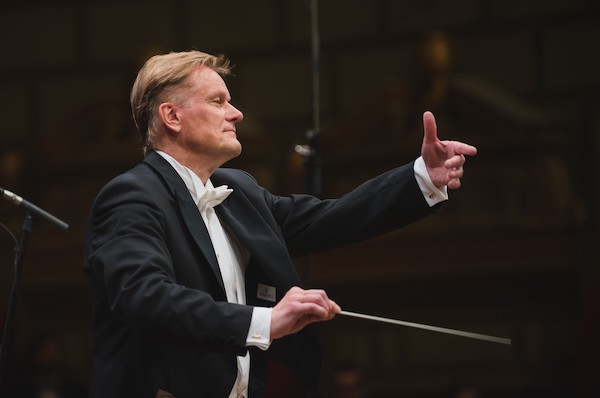Longwood Symphony fills prescription for good cause with orchestral showpieces

Dr. Stefan Willich conducted the Longwood Symphony and World Doctors Orchestra Sunday at Symphony Hall. Photo: Stefan Socaciu
“My time will come,” Gustav Mahler famously prophesied. And so it has. But even Mahler likely never imagined that some of his most complex and demanding music would enter the repertoire of nonprofessional orchestras and be creditably played by them.
Yet here we are: on Sunday, the Longwood Symphony Orchestra and World Doctors Orchestra—two ensembles comprised entirely of medical professionals—joined forces at Symphony Hall and offered, as the main event of their matinee concert, the Adagio from Mahler’s Symphony No. 10.
This elegiac 25-minute essay proved an apt choice, both given the musicians (“a stageful of frontline workers,” as the LSO’s Lisa Wong put it in comments to Sunday’s audience) and the event, which did double-duty as a fundraiser for Boston Health Care for the Homeless Program.
As led by Dr. Stefan Willich, the first of the afternoon’s two conductors, this was an Adagio that flowed purposefully. It was also admirably balanced, especially when its counterpoint was active. True, there were some spotty, exposed moments (the recurring viola motive, for instance, was never quite perfectly in sync) and string textures occasionally sounded thin. But the big moments packed heat and the lyrical ones sang fervently.
The afternoon’s other orchestral showstoppers, the 1919 Suite from Igor Stravinsky’s The Firebird and Arnold Schoenberg’s arrangement of J. S. Bach’s “St. Anne” Prelude & Fugue, offered, mostly, more of the same.
Willich drew a muscular, sometimes rough-hewn, account of the Bach/Schoenberg. Even so, the music always moved decisively and was strongly colored, especially in the whorling buildup to the fugue’s thrilling climax.

Lindsay Kesselman was the soprano soloist in Barber’s Knoxville: Summer of 1915 with Dr. Jeremy Faust conducting.
There was a good bit of color, too, in the Stravinsky, which was conducted by Dr. Jeremy Faust. His reading understood the distinction between foreground and background material, a musical feature professional orchestras can struggle with. Accordingly, its best moments included some of the score’s most delicate sections: the diaphanous textures in the “Khorovod” and the transition from the “Berceuse” to the “Finale,” chief among them.
Samuel Barber’s Knoxville: Summer of 1915 also boasted some fine orchestral playing. This 1947 setting of a text by James Agee is among Barber’s most popular works and, from the opening on Sunday, there was no question as to why. The combined forces, again directed by Faust, brought a lovely blend of instrumental color to the opening refrain and the extroverted spots—especially the evocation of a passing streetcar—offered plenty of bite.
Unfortunately, the orchestra tended to drown out soprano Lindsay Kesselman’s account of the text. When she managed to project over the ensemble, what emerged was radiant: pure tone, supple phrasing, excellent diction—in fact, the distinctiveness of her reading recalled Dawn Upshaw in this piece more than a little. It was a pity one couldn’t hear more of it; indeed, the balance issues were such that the vocal line sometimes felt like an adjunct to the proceedings rather than the score’s raison d’être.
Regardless, Kesselman’s efforts—and the orchestra’s—were warmly applauded.
To round out the afternoon, Willich returned to the podium to lead an encore of “Nimrod” from Elgar’s Enigma Variations. The last chord was held out for what felt like an exceedingly long time, as though conductor and orchestra, understandably, didn’t want the moment—and the concert—to end.
The Longwood Symphony Orchestra plays music by Weber, Villa-Lobos, and Mahler at Jordan Hall at 8 p.m. October 29. longwoodsymphony.org
Posted in Performances



